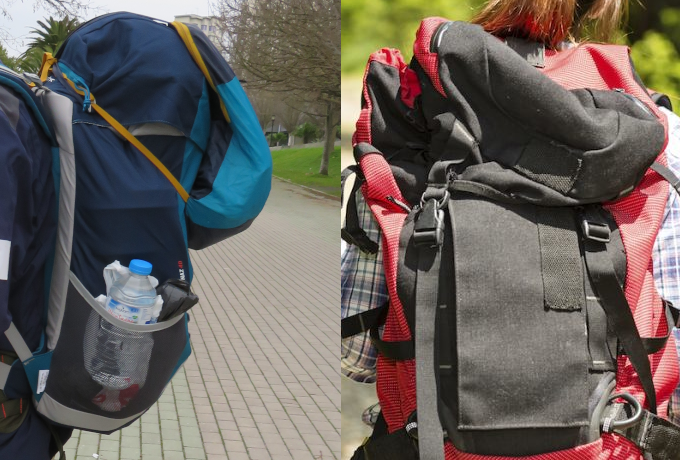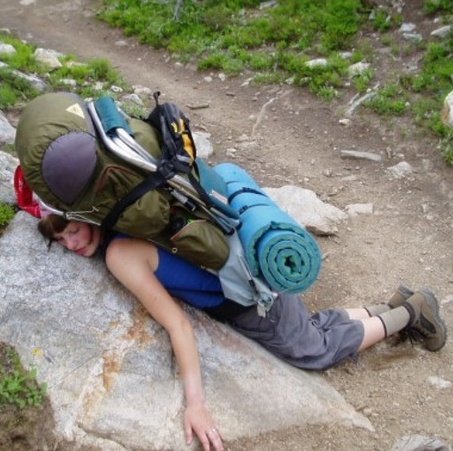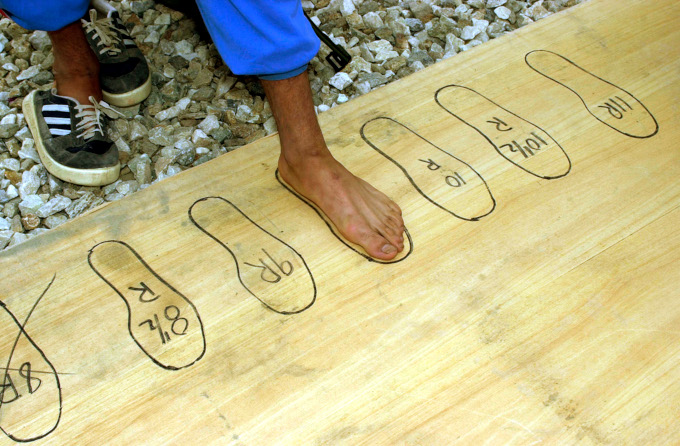Preparing for the Camino is an adventure in itself! It’s difficult to know what to do and how to equip yourself, especially when you are new to all of it… Thankfully, the pilgrim community is there, always ready to offer a helping hand. It’s a real blessing! But be careful, even if intentions are good, there are sometimes bad advice going around… The ones I discuss here are unfortunately so prevalent you can get them everywhere!
In this post, a quick tour of advice to ignore at all costs… and stop sharing. And alternatives that will be working for everyone!

Photo: Marion, Santiago in Love, CC BY-SA-NC
1. “A 30L backpack is waaaaay enough”
Variation: “Take a 35L, it will be enough” or “If you camp, you need a 60L, at least”. Comes in all volumes: 30L, 35L, 40L, and so on

Right: not full at all and collapsing on itself, the bag is too big!
Photos: left Marion, Santiago in Love, CC BY-NC-SA and right Istockphoto.com
Why is this bad advice?
Let’s say it right away: yes, it happens that a 30L backpack is ok. Or a 60L for camping. But if “it happens”, it doesn’t make it good advice, it makes it a fluke!
Even if they are meaning well, many pilgrim-advisors… don’t actually give a piece of advice. They’re sharing their experience, telling you what worked for them.
It’s very nice, but far from useful in a practical way: who says that what worked for this pilgrim will work for you? You will probably find yourself in this situation, so be careful and differentiate between personal experiences and real advice!
A fitting backpack is essential for your pilgrimage to go well. Not only for a simple question of volume management! Whether too big or too small, picking the wrong volume creates difficulties to pack your gears and to carry your backpack efficiently and comfortably.
If you get a (X) liters pack and your stuff don’t fit in, it’s an obvious problem. You’re left with gears you can’t place inside your backpack…
If you get a (X) liters pack you can’t really fill up, it’s a problem as well. When a backpack is too big, the extra space makes it hard to pack the content efficiently and in a comfortable way. Things tends to move around more, creating lumps and shifts in weight. It can also be harder to position, strap and carry correctly and comfortably.
It’s possible to give a rough estimate of the backpack capacity someone may need, based on that person’s preferences (albergue or camping, restaurant or cooking) and on what most pilgrims carry in the same situation. But this estimate is not really reliable and here are 2 reasons why:
🧐 First, because when this estimate comes from fellow pilgrims, it’s based on perceptions, not hard evidence. Walking the Camino obviously gives everyone a lot of opportunities to see and compare a variety of different backpacks. However, it still doesn’t give pilgrims a trustworthy insight on their volumes! There’s a real gap between what pilgrims think is the common/average backpack size on the Camino and what it actually is.
Indeed, many people seem to consider this average to be ~30-35 liters, while it’s in fact ~40-50 liters! (For a pilgrimage on foot and sleeping in albergues; what most pilgrims have AND what really fits. The too many 30L-packs with half of the stuff hanging outside because they don’t fit in… don’t count!)
🧐 Second: what guarantees that any estimate or averages apply to you? A backpack is such an important piece of your equipment, it should really be selected based on your personal needs, not on generalities!
(Edit) Let me take a small break here to write an important note on stuff hanging outside of pilgrim’s backpacks…. I got lots of feedback from people defending it!
In this post, I’m actually not talking about the “convenient hangings” that are done by choice. Everyone (myself included) hangs things outside of their bags, and it’s a very useful practice! For example, a rain jacket to have close-by because it may rain, some wet laundry left outside to dry, dirty shoes that are obviously better out than in, a bulky mattress that would never fit inside the pack, and so on!
No… Here, I’m talking about “hangings” that are not a choice. It happens when a ill-fitted backpack forces pilgrims to attach “leftover gears” on the outside of their pack because there’s no more room inside… It may seem unreal, but there are actually A LOT of pilgrims in this situation!
It’s really better to have a backpack that really fits and then hang things outside if you want it 🙂
Back on tracks… We were discussing generalities!
By definition, generalities don’t take individuals into account. So, estimates don’t always work when we want to use them to make personal choices and decisions.
For example, pilgrims often think that sleeping in albergues = small volume backpack. It can be true! But a pilgrim who sleeps in albergues may just as well need a 45 liters pack. Because it’s the best s-he could do to reduce his gears or because her-his sleeping bag and/or fleece (or else) are bulky. Or because her-his morphology makes a bigger pack more comfortable to carry, or for any other reason!
On the other hand, pilgrims often think that sleeping outside = big volume backpack. Once again, it can be true! But a pilgrim who sleeps outside can be 100% equipped and fit everything in a 35L pack. It may be more tricky than for pilgrims who sleep in albergues but it possible! And it’s becoming more and more common with the rise and spread of the lightweight hiking philosophy.
To sum it all up… It’s impossible for anyone to give a good advice on the ideal size of your backpack without knowing about your project and the actual gears you will use. The volume of a backpack in liters depends on many parameters. Like the season, the type of accommodation, the volume of the things carried or even the person’s morphology! It’s such a personal and important item, please chose it with care and thinking of your needs first!
What’s best instead?
Buy your bag last, after you have gathered the rest of your stuff. Strange? Maybe, but if you only remember one thing, remember this!
The excitement of the upcoming departure and preparations makes you want to buy your bag right away… Understandable. However, you will really benefit from waiting! Once you know what you’re going to take with you, the question your backpack’s size will almost solve itself, because you will have a precise idea of the volume you need!
It’s only logical… If you rent a storage unit, you do so after you’ve estimated the volume of your stuff as best as possible. Otherwise, you’ll either end up with stuff on your hands, or you’ll be paying for empty space. Same goes for your bag!
Once you’ve gathered your gears, use one or more of the following techniques to get an idea of their volume… and of your future backpack:
Be careful, don’t forget to include water and food!
🤓 The garbage bag trick: fill one with all your stuff and check its size. Is it a 30L? A 40L? A 50L? Bingo, so easy! It also works with a travel bag or a suitcase whose volume you already know
🤓 The friends trick: borrow hiking backpacks around you to test them with all your stuff. Again, works with travel bag or a suitcase whose volume you already know
🤓 The store trick: go to the store with your stuff and try out various backpacks. This is recommended anyway to test different packs “in real life”.
Once you know the volume of your equipment, have it in mind as a reference. Don’t take anything smaller, but accept a small margin of difference to choose your actual backpack.
A volume a little bigger than just the one of your stuff will allow you to pack everything comfortably. You will also be able to add unexpected items more easily. Like fruits received or plundered in an orchard, extra water or that sleeping bag you had to buy on the way because you didn’t think of it before (yes, it’s common!)… 😉
Flexibility is especially true as you need to take other criteria into account when you choose your backpack. The most important of all: your backpack’s size in height, relative to you’re back’s length. This one is more important that your pack’s volume!
Here you are! Ready to find the perfect backpack’s volume… that fits your particular needs!
2. “Your bag must be a maximum of 10% of your body weight”.
Variation: “8kg? But you’re 70kg, so that’s way too heavy! “or “Your bag should be no more than 15% of your weight” or 20%, depending on the source…

Why is this bad advice?
Several explanations! I’ve already detailed them in this article I dedicated to this (in)famous “10% rule”. Here they are again, in a few points:
- Because this “rule” is not a rule. It’s a purely arbitrary and approximate calculation!
- Because it should not be used as it is. It should never be “10% of one’s weight”, it should always be “10% of one’s healthy weight”.
- Because used as is, it makes no sense. Yep: it implies that the heavier you are, the heavier your backpack can be… Which is absurd!
- Because nobody (nearly) uses it correctly. That’s to say, everybody (nearly) uses the absurd version of this “rule”
- Because if you want to use it correctly, it becomes very complicated very quickly. First you have to calculate your healthy weight (which is no easy deed) and then only the weight of your pack
- Because even when it’s used correctly, it ignores a lot of important factors that greatly influence the carrying capacity of each individual. Morphology, physical shape, health, etc etc.
- Because all things considered, this 10% is more a source of stress than anything else
- Because this “rule” is not a rule. It’s a purely arbitrary and approximate calculation!
Yes, I know, this last point, I already said it! But it’s worth repeating it again 😉
So, here you are: so many reasons to ignore this bad advice and take a different approach to packing your bag!
What’s best instead?
For starters, stop beating yourself up if your bag is over 10 pounds. The human body is capable of wonders, including carrying heavy loads. In most cases, a bag up to 20-24 pounds is quite transportable! The human body also has an incredible capacity to adapt: it’s by carrying weight that we get used to do so. And the more we are used to carry weight, the easier it becomes!
Some people worry sick if they think their bag is too heavy for them… It’s quite sad! Because the very same people often have the capacity to carry their pack as it is. Many pilgrims arrive on their own at a final weight (way) under 20 pounds.
That said… It’s clear that light weights are easier to carry. Even more so if you have a limiting physical or medical condition…
So, rather than getting into calculations and fret yourself with the result, why not make it simpler? Have one simple guiding principle in mind: “the lighter the better”.
From there, just do your best. Lightening a backpack is a whole process! There is no such thing as a perfect backpack, there’s always room for improvement.
There are also no shortcuts… You have to know yourself and the options available to you. To take the time to test, change and adapt your equipment bit by bit. It requires spending time to do all of it. But all this investment will pay off and little by little, you will end up with a lighter backpack!
A little note to finish. Whether the advice were asked for or not, it’s unfortunately a common practice to shame pilgrims with a pack that’s considered heavy. Or at least, to give unhelpful remarks and lectures. A sharp or mocking comment, weighing up a pack without permission … and so on. How annoying!
Impossible to control gossipers… If this happens to you, turn a deaf ear and think of the saying, “sticks and stones…” 🪵🪨😉
3. “Above all, take 1 size up for your shoes”
Variant: “Take a size 1.5 bigger” or 0.5 or 2 sizes bigger, depending on the source…

Photo: Sgt. Kevin P. Bell, U.S. Army
Why is this bad advice?
Let’s say it right away (again). Yes, sometimes people do need to go up 1 size. Or 0.5 or 1.5 or 2. But again, if “it happens”, it doesn’t make it good advice, it makes it a fluke!
Let’s start by understanding why people give this advice
When hiking, especially on a long distance trail, feet produce an effort much more diverse and intense than in “normal life”:
👣 On the one hand, there will be more movements in the shoe. Forward downhills, backward uphills. Right and left depending on the unevenness of the ground. More subtle but natural, upward for the forefoot and toes. All of this repeated all day long, for a few days or even a few months!
👣 On the other hand, the efforts provided lead to variations of the feet’s anatomy: they heat up, swell, can change shape, lengthen and widen.
👣 All together, these effects explain why your feet are much more “aware” and sensitive to the size and sides of your shoes. As such, they have a vital need for shoes that offer them enough space to move and transform without being injured.
That’s why people advise you to take a size bigger than the shoes you wear in your “normal life”! In theory, this allows you to find shoes that will respect the needs of your feet during your pilgrimage.
In theory? Yes, in theory! Because we’re now touching the heart of the reason why this advice is bad advice: the shoe sizes. Indeed, if the intention is good, it’s impossible to find the perfect shoes by taking your “normal” shoe size as a reference and adding one unit (or more) to it.
Why is that? Simply because shoe sizes are an artificial and arbitrary measurement system.
And not just that: there are actually many different systems and units of measurement across the world, each with a specific way to determine the size of a foot… and therefore of a shoe.
To make things even more complex, other factors come into play to determine shoe sizes, like the brand’s country of origin or the designers and manufacturers involved in the fabrication process of each pair of shoes…
In short, this virtually leaves us with a different sizing system for every type of shoes!
All Greek to you? Just remember that for one given shoe size, the actual size (length) of the shoe can be greatly different from one brand to another. And sometimes, even from one type of shoe to another within the same brand.
For example, for the same pilgrim (for the same sizes of feet), the perfect shoe-size can be between +0.5 and +2.5 depending on the brand and/or type of the shoes. Less common but still possible, some shoes require to be converted with negative shoe-sizes, i.e. to take smaller shoes than usual.
I can hear you thinking, “thank God there are international charts to make sense of this mess!”. They are indeed meant to help convert shoe-sizes from one sizing system to the next.
But be careful! They can be useful but they are far from perfect! You should never base any final decision based on this tool alone!
(Note 1: A surprising number of people actually wear shoes that don’t fit their feet in their “normal” life! A baseline that is all the more wrong when it comes to finding the perfect hiking shoes…)
(Note 2: Some professionals are able to find the perfect shoes when you give them your “normal” shoe size. This is because they know their products inside out and are used to making the specific conversions for each brand/type of shoes they offer! Some of them are also able to judge size by sight, just by looking at your feet. Like magic! 🧙🪄 )
What’s best instead?
Everyone agrees. Having shoes that fit perfectly is crucial to a successful pilgrimage. Too small or too big, the slightest thing that’s wrong will affect your comfort and health. And not only for your feet! As the foundation and base of your body, a problem with your feet (shoes) can have an impact on your whole body: ankles, knees, hips, back, shoulders, and so on!
So, shoes, but not just any shoes! How can you pick the right ones, given everything you now know about your feet and about shoe-sizes?
Since you can’t trust the numbers on the label or the box, forget about the shoe-sizes and trust your feet, just and only your feet!
(Well, okay. Use your “normal” shoe-size as a reference to select a first size to try on. But then, select shoes with your feet!)
Next, learn how to do an effective shoe fitting process:
- Golden rule. If you feel any discomfort or compression when putting on the shoes, switch to another size or design. You need to feel good in there right away!
Contrary to popular belief, a pair that really fits doesn’t need to be broken in to become comfortable! - Preferably go for trying shoes at the end of the day. Your feet will be a little swollen, which is perfect to find the right shoes more easily
- Try on shoes with your hiking sock and insoles (if you have some)
- Once in the shoe, move the foot forward so that the toes touch slightly in front and bend the leg a bit while keeping the heel on the ground. You should be able to slip a finger behind the heel. Difficult or impossible: the shoe is too small. Very easy or a lot of space: it’s too big.
- Lace your shoes properly!
- The toes should not touch the front or be compressed on the sides.
Once laced up, use the downhill test platforms (if there’s one) or tap the front of the foot on the ground: if the toes touch in front, the shoes are too small!
Play the piano with your toes, spread them: if they are uncomfortable and/or compressed, the shoes are too narrow. (Be aware that in some brands and shoe-designs, there are different widths for the same size! Also, men’s shoes are generally wider than women’s) - When you have found a model that fits, make sure you try on both feet! They often have a small difference in size: the final size of your shoes should be the one that fits your strongest foot perfectly!
Keep them on your feet for a while and walk around. Take your time, try on different types of shoes. - Again, at all times, remember the golden rule!
By trusting your feet rather than shoe-sizes, you’re bound to find the perfect pair of shoes. Your feet will thank you and love you… and your Camino will be all the more amazing! 🦶❤️🤩
There you go! You’re now equipped to spot bad advice and avoid them.
How about you? Have you ever read or heard any of them? Have you ever given any of them?
Tell us in the comments! 🙂





Great advice! Especially the 10% “rule.”
My advice is to take what makes you comfortable so long as you can comfortably carry it.
you want to be as light as possible for the long journey, but beware as i said it is a long journey 😉
Thank you for the informative tips
Great advice but a word to the shoe manufacturers… not every male has big feet! Mine measure size 5 in UK/IRE and are very wide. Trying to find shoes/boots that fit is a nightmare as there don’t seem to be any “in-between” sizes and most start for males at size 7. Womens sizes are quite narrow and the colours are a bit bright for my taste. Slippers are fine as those for kids are big enough as long as you don’t mind Batman or Superman on them 😃. So… any ideas for my footwear? 🤔😀
Thanks for your comment Garry 🙂
It’s so true that when you don’t fit into “normal” standards, finding shoes (or clothes) simply becomes a headache! Unfortunately I don’t really have any trick that could help you stay away from Spiderman or Hello Kitty shoes… or even pink women shoes 😅
You’re perfectly right, men shoes usually start with bigger sizes than women’s. So, your best bet is still to look in the women’s department… Check for brands that make shoes that come in “regular” and/or “wide” features, like eg Lowa or Keen. (Both make shoes in neutral colors, even for women! 😉 )
It’s always best to try shoes on before you buy a pair… but stores always make a selection of products based on what is more saleable: there’s no chance you’ll find the entire collection a brand actually offers and few chances they’ll have the ones with unusual features. Brand stores are the exception, but you can’t find them everywhere.
An option is to visit various brands’ websites: use the filter option to check, see and pre-select the shoes that may work for you. Then, you can call the closest retailer to know if they have the shoes you’d like to try. If not, ask if it’s possible to order a pair for you to try on (but to be fair, stress the fact you may not buy them if they don’t fit). Maybe they will agree! If they do, they’ll most probably ask what size you’d like, so have an answer ready 😉
Otherwise, you’re kind of stuck with online shopping… In this case, here’s what I’d suggest. Look for the brand you’re interested in in a store and try a pair to find the size that fits you in length. It’s not a promise it will be the right one, but it’s a better guess on what may fit. So, keep that size in mind, then on the brand’s website, select and order shoes of that size but from the brand’s wide-feature selection. Once you get the shoes, try them on thoroughly: it they fit, yey! Congratulations! 🥳 If not, return it and eventually start over with another size or type of shoes, depending on what was wrong with the shoes you tried on. In any case, check the return policy first to know how it works and under what conditions. I realize it would be a tiresome process but if it makes you find shoes that fit… it would be really worth it!
I hope all of this can help your quest of the best-fitting hiking shoes 🙂 Animo peregrino!
I couldn’t possibly agree more with all three of these, but especially the third one. Using American sizing I wear anything from a size nine to an eleven. I first recognized this when I was in the military. My dress shoes were a size seven, combat boots were 9 1/2 and running shoes were 10 1/2. Now I live in Europe where their sizing seems less dramatic, but I have put on tight fitting 43 1/3 shoes and found the 44s to be too big. Add that I have really wide feet and you can guess that I never ever buy my footwear by mail.
People ask about rucksack litreage as a sort of proxy to ask ‘how much should I take’. You say your pack should fit your gear, and thats right, but there is certainly more than you can say than that.
If a person is carrying a 50 litre or bigger rucksack for a summer Camino, barring medical equipment or other unusual requirements, if they have filled that pack there is simply no way they need everything inside their pack. They are either carrying unnecessary multiples of things, very bulky versions of things, or stuff they really don’t need. Even people intending to camp don’t need a pack that big.
Someone choosing a pack that big is a flag that they have misunderstood something about the nature of the journey. They are literally making a rod for their own back, and have increased the chances of injury and pretty much assured lots of unnecessary discomfort. Sure people can carry what they want, but when someone asks for advice, they should be given good advice, and good advice in the case of rucksacks is that you don’t need a large pack for this journey.